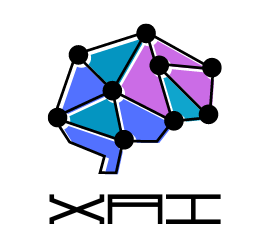“For there exists a great chasm between those, on the one side, who relate everything to a single central vision, one system more or less coherent or articulate, in terms of which they understand, think and feel – a single, universal, organizing principle, in. terms of which alone all that they are and say has significance – and, on the other side, those who pursue many ends, often unrelated and even contradictory, connected if at all, only in some de facto way, for some psychological or physiological cause, related by no moral or aesthetic principle.”
— I. Berlin [The Hedgehog and the Fox]
Miniature Swarm
Assumption:
The central hypothesis states that a collection of identical cognitive units can interact in a coordinated fashion to produce deterministic macro-level behavior. It is further postulated that for any given condition, there exists within the repertoire of available tactics a definitive, intelligent approach. The selection of the appropriate tactical scheme has meaningful implications. Strategies arise through combinations of the accessible tactical primitives (the ordering within strategies may differ). Emergent phenomena can manifest via the enactment of multiple concurrent strategies. However, the emergent global behavior remains invariant across all possible strategy combinations.
Consider the miniature swarm model introduced previously (shown below). The miniature swarm consists of three agents equipped with four distinct tactics each. Individual tactics collaborate to form strategies and it is assumed that all strategic collaborations ultimately lead to the same global emergence. All strategic maneuvers employed by the swarm attempt to achieve an embedded global behavior by various means. The idea is that the strategies utilized by the swarm seek to attain a state of strategic equilibrium with environmental conditions.
Data:
- Environment (Є)
- Elements: E1, E2, E3
- Conditions in Є: 1, 2, 3
- Number of distinct tactics available to each element (for each condition): 4
- The total number of tactics available to the miniature swarm: 36
- The total number of strategies available in combinations: 6.8719476069 x 10^9
- The total number of strategies available in permutations: 1.01118 x 10^42
- The total number of strategies available in replacement combinations: 4.42513 x 10^20
- The total number of strategies available in replacement permutations: 1.09427 x 10^56
Where,
- Combinations: Refers to the number of ways to choose r strategies (where 3 < r < 36) from the total set of 36 available tactics, without replacement. Order does not matter in combinations.
- Permutations: Refers to the number of ways to choose r strategies from the 36 available tactics, without replacement. Order matters in permutations, so different orderings of the same set are counted separately.
- Replacement Combinations: Refers to the number of ways to choose r strategies from the 36 tactics, with replacement allowed. Order does not matter.
- Replacement Permutations: Refers to the number of ways to choose r strategies from the 36 tactics, with replacement. Order matters, so different orderings of strategies with repeated elements are counted separately.
In summary: Combinations and permutations do not allow repetition of the same tactic within a strategy. Replacement combinations and permutations allow repetition of tactics within a strategy. Order matters for permutations but not for combinations.
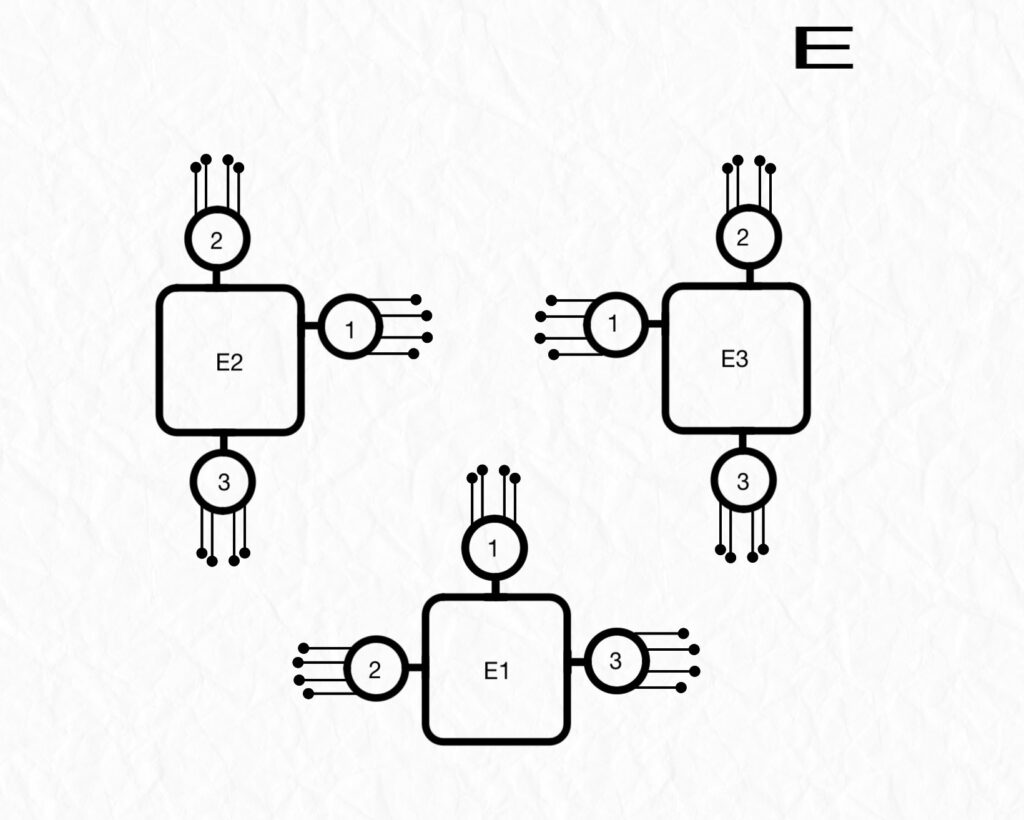
Thus, for any of conditions 1, 2 or 3, a set of strategic probabilities exist within the swarm (or within the environment) which constantly push for equilibrium. If these strategies are visualized as pseudo-probabilistic gridlines within the environment, they would appear to create a dynamic possibility map enforcing all agents to employ relevant tactics for corresponding environmental conditions 1, 2 and 3. Note this is a highly idealized model which assumes the behavioral emergence of the swarm is constant regardless of the strategic combinations utilized.
If the assumption that “all interactions ultimately lead to the emergence of an embedded global behavior” is valid for the case of the asserted deterministic behavior of the miniature swarm, then the hypothetical probabilistic grid depicted below is applicable to all potential iterative interactions within the environment. The grid is only to show how a wave of innumerable possibilities exist within the environment.
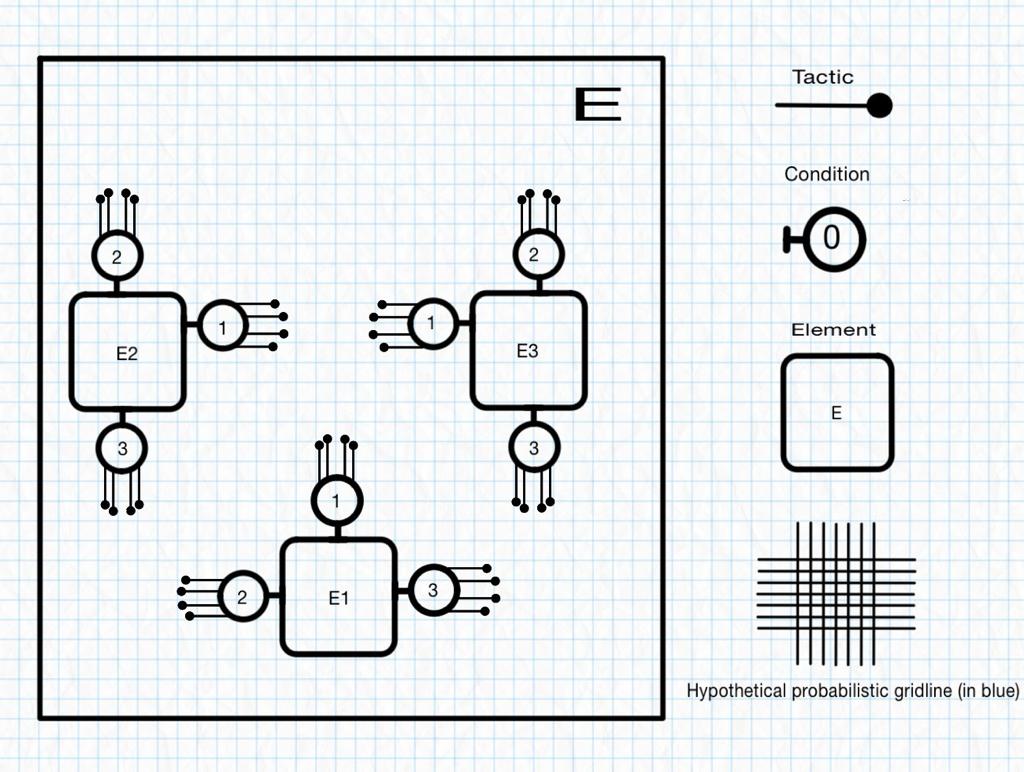
The preceding diagram serves to illustrate the framework for a hypothetical scenario grounded in determinism. A mathematical generalization for an analogous model comprising ‘n’ tactics is provided below:
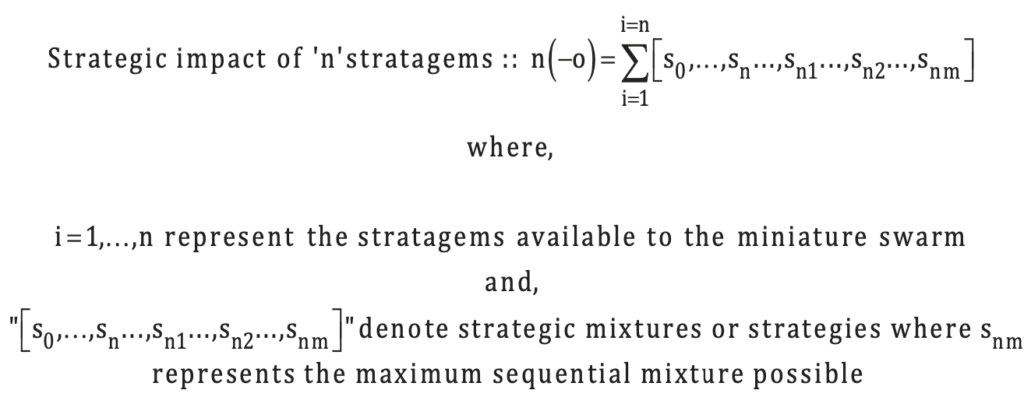
Equation 1 depicts an n-tactic model in which the swarm possesses ‘n’ tactics to engage with the environment. The function [s0,…,snm] symbolically denotes the total number of viable strategies.
Frame-Systems
The blog post Neural Networks discussed the concepts of frames and frame-systems and suggested their utility. As described previously, the proposed framework helps record decentralized knowledge using distributed logic. To briefly summarize key aspects for reference: A frame is a network of interconnected nodes and relations representing a concept. Frames contain fixed top-level components with consistent information and flexible lower-level components with slots for specific details. Terminal assignments embedded in the lower levels provide detailed knowledge and data. Marker conditions in the lower levels retain essence of a related stimulus. Default assignments enable flexibility in applying the frame.
A frame-system is a set of associated frames with shared terminals representing perspectives on a stimulus. Transformations between frames mimic effects of actions by shifting viewpoints. Frames coordinate information through terminal linkages. Frames and frame-systems function as analytical tools to examine a stimulus relative to imprints from prior experience. Their properties can be leveraged for programming applications. A basic frame with predefined components can model improving strategies. Accumulated memory from repeated experiences enables analytical perception. Interplay between dynamic viewpoints in a frame-system generates holistic perception. As Minsky describes, “inter-frame structures represent knowledge for understanding” a stimulus.
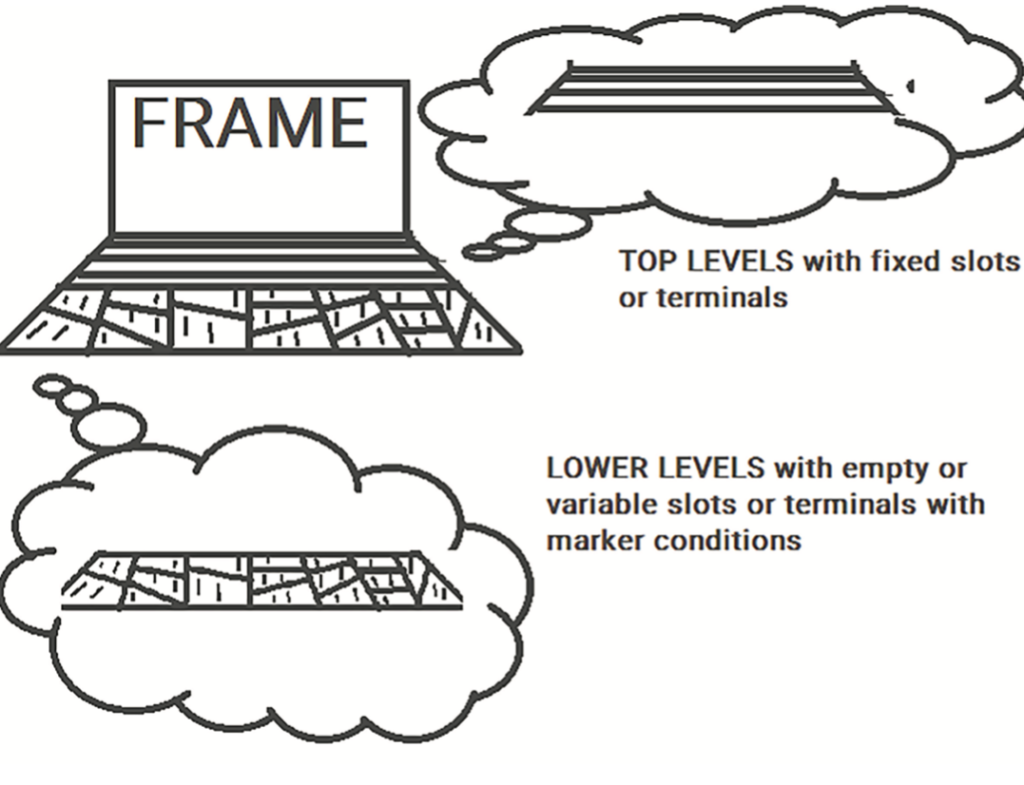
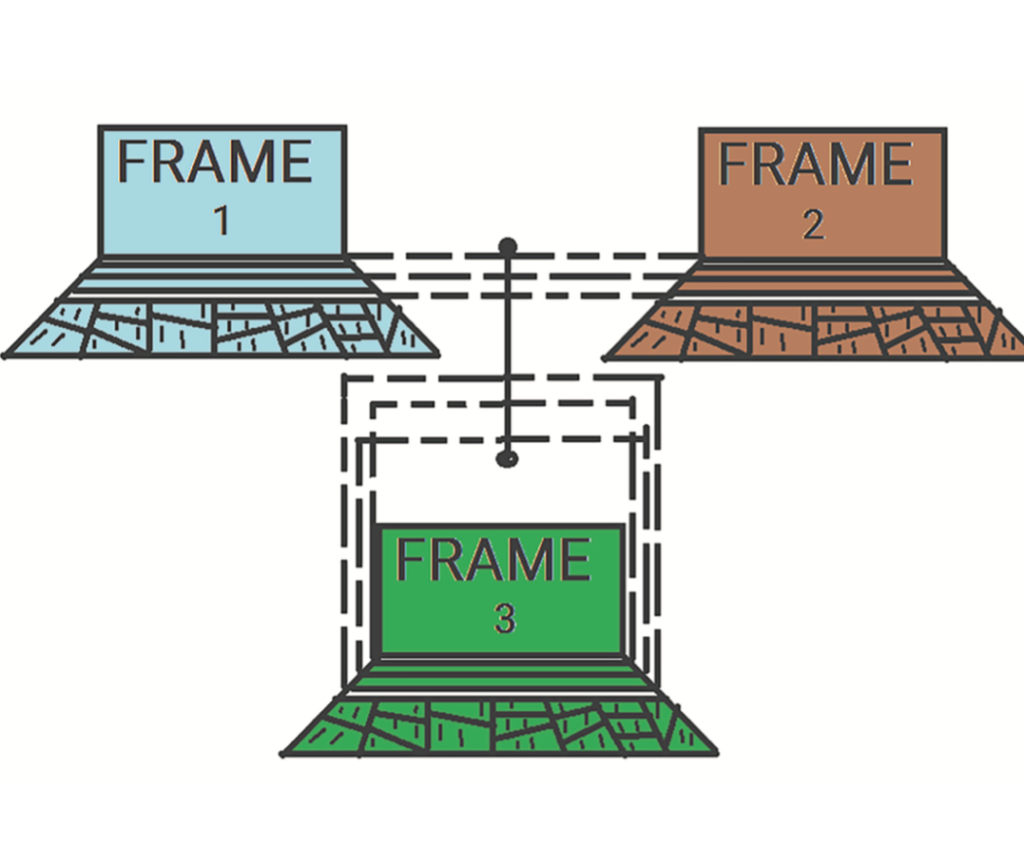
It should be noted that the illustrated frame-system (Figure D) can contain any number of frames as opposed to just three frames. The additional frames can represent additional perspectives, causal relationships, or actions related to the stimulus or situation being modeled. In this way, the frame-system provides a flexible structure that can incorporate many viewpoints and relationships to enable richer, more nuanced analysis and understanding of the stimulus. The use of n-number of frames allows the modeling of complex real-world situations with multiple interacting components and relationships. As the number of frames increases, the frame-system becomes capable of more sophisticated analysis and perception of the represented concept.
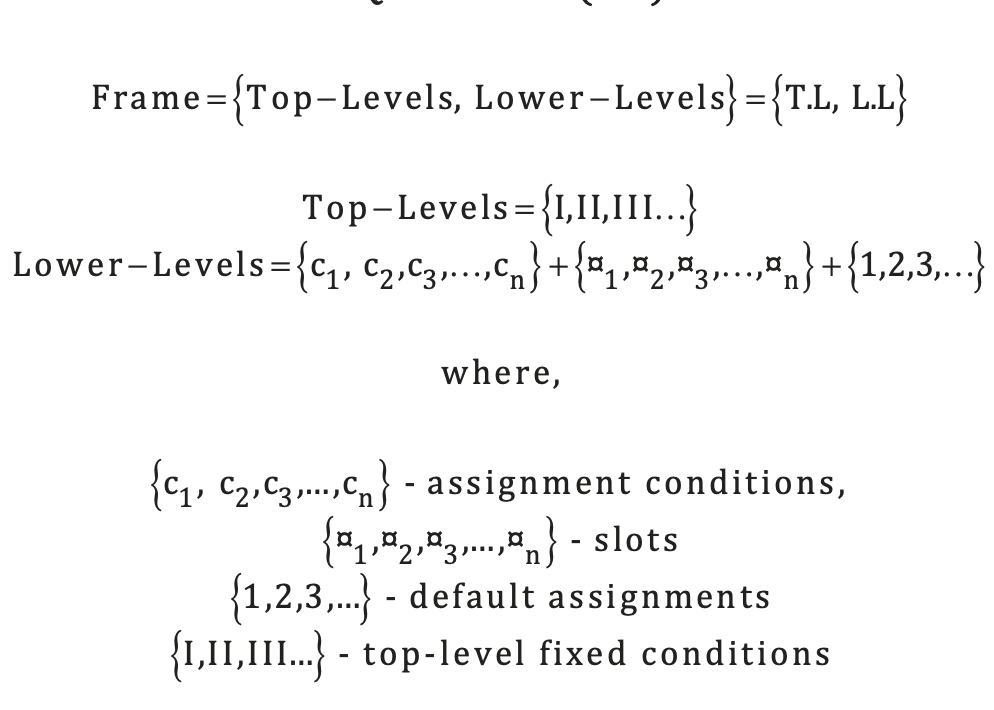
As shown in Equation 2, a frame can be mathematically represented as a combination of top-levels and lower-levels containing fixed, variable, and empty slots. This equation provides a generalized mathematical format for frames that can be leveraged for programming purposes. By formally defining the frame structure in this mathematical way, the format can be implemented in code to create frame-based systems. The ability to programmatically generate frames provides a foundation for artificial intelligence systems that can perceive and understand concepts through layered networks of frames and frame-systems, similar to human cognition. This mathematical formalization of frames is an important step in translating the conceptual theory of frames into a concrete computational model.
C.U.I
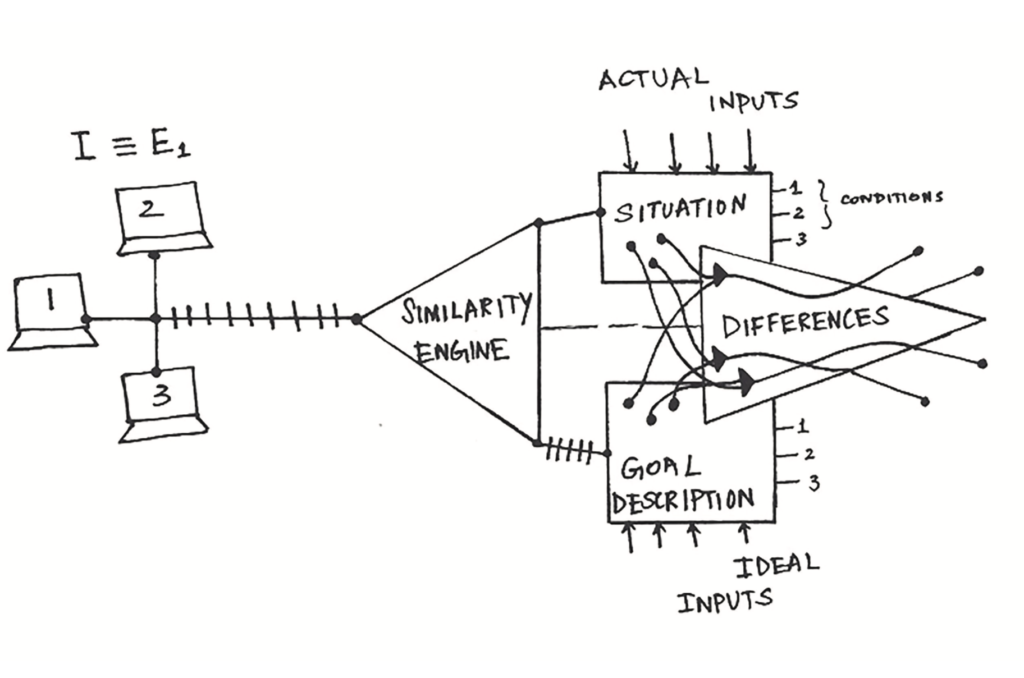
Key features of a CUI include:
- It contains a frame-system, similarity engine, and difference engine
- The frame-system enables perception
- The similarity engine connects the frame-system to the DE by selecting an appropriate frame to provide a goal description to the DE
- The DE generates a goal description and action strategies to reduce discrepancies between actual and desired situations
Frames and frame-systems serve purely analytical functions. A unit of intelligence requires capabilities of perception, analysis, and action. A CUI becomes equivalent to an element E of a miniature swarm when following the Perceive, Analyze, Act (PAA) process:
- Perceive: The unit perceives a stimulus/situation and produces corresponding frames and frame-systems
- Analyze: The similarity engine concurrently analyzes the actual situation per the frame-system and the desired situation required by the DE. The desired situation is pre-set in memory or the information retrieval network. Through dual analysis, the similarity engine provides the DE with suitable goal descriptions and ideal inputs.
- Act: The DE formulates action strategies based on the goal description.
Stigmergy
Using the generated designs, the cognitive structure of elements in the miniature swarm is expressed (microscopically) using cerebral units of intelligence or CUIs. To understand the expansion of the model and its relevance, a deterministic atmosphere of swarm interaction is detailed next. Deterministic Atmosphere: The macroscopic model in figure F is incomplete with respect to the microscopic model in Figure G. The following summary will help understand this presumption.

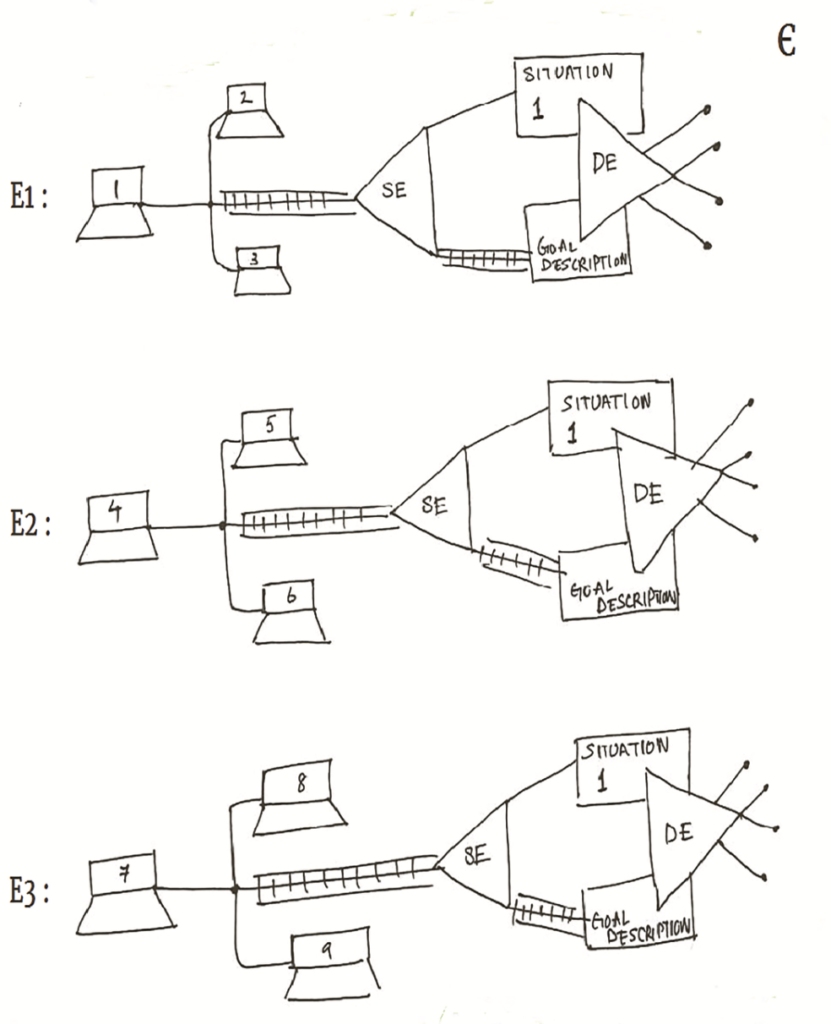
Figure G: Microscopic view of the miniature swarm; each element is shown equipped with multiple frames and a similarity-difference engine
Macroscopic View (Figure F):
- Elements of the swarm are homogeneous and have predefined tactics for conditions 1, 2 and 3.
- They communicate or coordinate by building strategies from predefined tactics. The nature of communication, although, is unknown.
- Built-up strategies allow swarms to achieve global emergence. – All (probable) strategies are estimated to bring about the same global emergence.
Microscopic View (Figure E):
- Action tactics are spawned using a process – perceive, analyze and act.
- Elements in the swarm are expressed using cerebral units of intelligence.
- Each element is equipped with a frame-system, a difference engine, and a similarity engine which operate on condition 1, 2 or 3 of the environment as illustrated (Figure E).
Evaluation
Tactics are formed in the microscopic view and they are predefined in the macroscopic view. If the presumption that “all strategies ultimately result in an embedded global emergence” is accurate, there must exist some indirect communication using which individual tactics of the elements harmonize to form effective strategies.
Incompleteness arises because the method of communication (or coordination) is unclear. Although, it should surely be indirectly coordinated communication in force if deterministic assumptions tied to the macroscopic view are pressed to be correct; otherwise the models would become redundant.
The evaluation made reflects the notion of stigmergy i.e., indirect coordination as the only missing link in explaining swarms with a prototypical method of communication. So, to integrate the microscopic and the macroscopic representations of the miniature swarm, a foundation in stigmergy is required.
Building the foundation for stigmergy
A model which explains or resolves the following delineations will attain a deterministic explanation for swarm behavior.
- Swarm, a cerebral social interaction in a chaotic substrate with a fixed result
- A stimulating configuration, frequency, and cerebral intelligence in the play of events connected to swarming
- Microscopic decentralized decision making and macroscopic decentralized strategic interaction • Robustness in dimensionality
- Particle-continuum models of representation
- Chaotic interaction as complex network analysis
- Game theory as a potential method and equilibrium as a possible solution
- 1D-2D-3D depiction of cognitive elements using game theoretic models or applied game theory
- A simulating emphasis of social interaction in swarms
The foundation in stigmergy is built by exploiting the concept of memory or the information retrieval network (I.R.N). It is established from the literature review that indirect communication is not just a possibility but the norm. Under the assumption that the “problem-solving ability is encoded in the architectural framework of the system” (Schuster, A, Yamaguchi, 2009), the following conclusions are drawn,
- If an element in the swarm can perceive its environment, it must likewise be able to perceive other elements in the environment.
- As a result, each cognitive element must be equipped with frames which correspond to other elements in the environment.
- Every frame system in an element of the swarm must be prepared with frames meant for individual performance and indirect cooperative tactics or stigmergy. Equation 3 explains this mathematically.
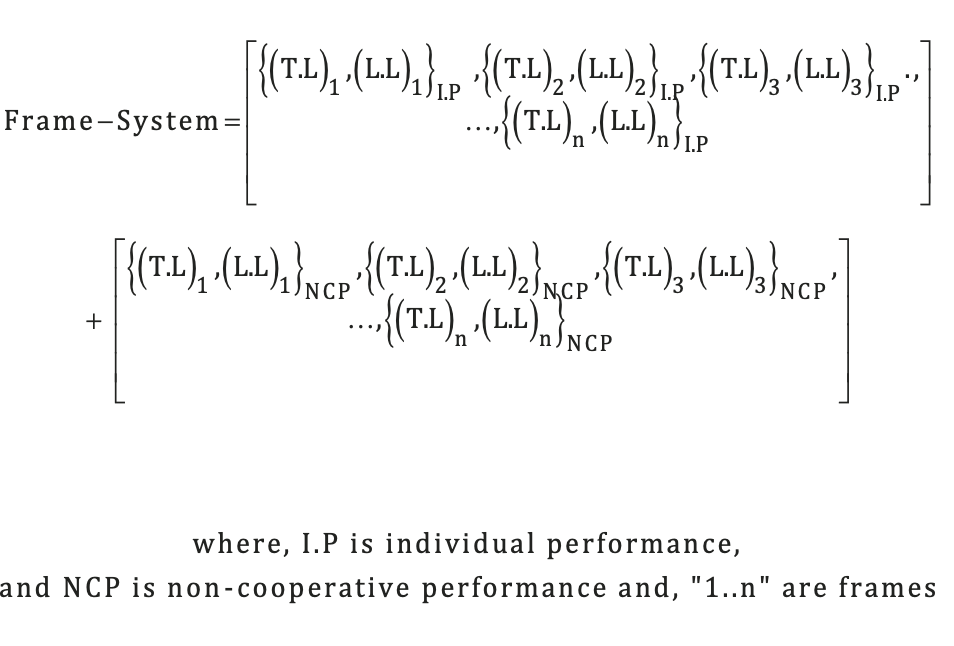
The information retrieval network (I.R.N) was characterized as the ‘dynamic memory’ stored within cognitive elements. As previously stated, “…In the current framework, the I.R.N functions similarly by providing access to an inter-connected frame system that contains frames with terminal markers and conditioning that better match the perceived reality. This allows a level of dynamism in the processing of a given situation.”
However, the realization that cognitive elements not only anticipate changes in environmental conditions, but also detect possibilities for social collaboration, requires an explanation that positions the I.R.N not just as a facilitator of dynamic memory, but also as a mechanism for collaborative social memory or stigmergy (see Figure H).
Therefore, the information retrieval network (I.R.N) can be conceptualized as an interconnected frame system that enables both independent and collaborative performance. The frames within the I.R.N must contain mutually accessible knowledge to support coordinated actions between all elements in a swarm.
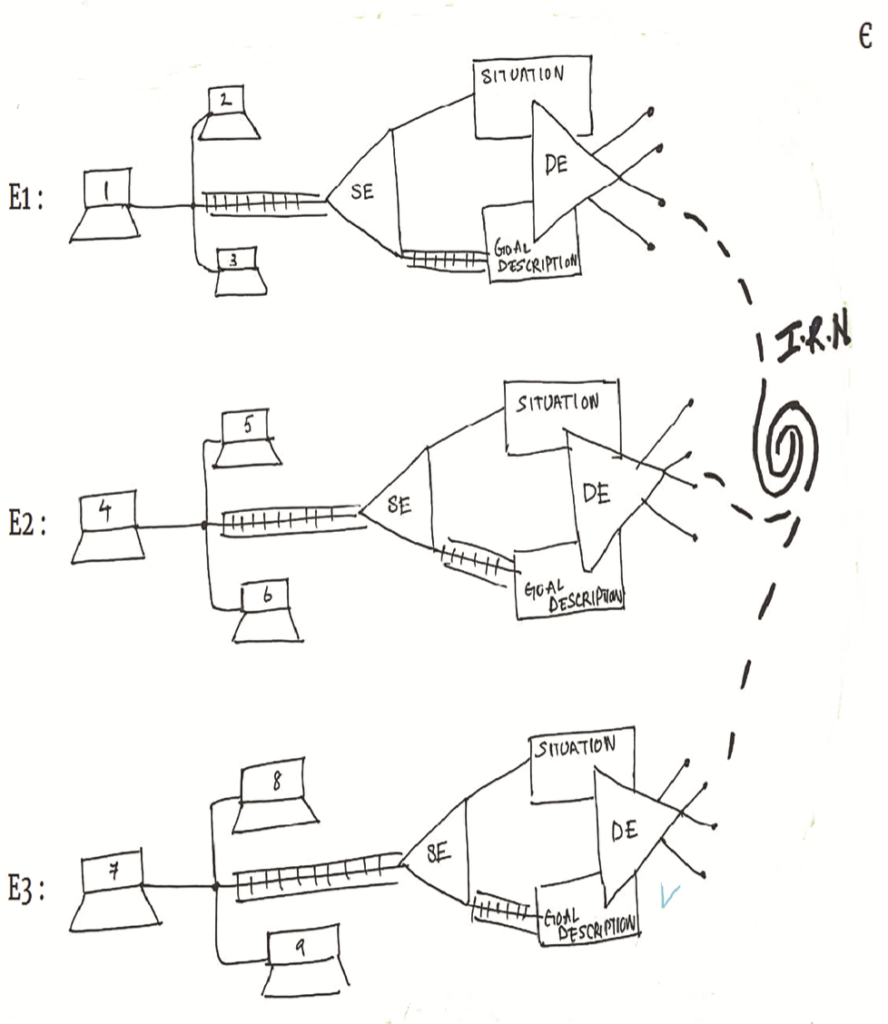
The Information Retrieval Network (I.R.N):
- Enables stigmergy by providing appropriate frames based on globally perceived environmental situations
- Represents both individual and collective memory, i.e. availability of frames for individual performance and self-enforced collaboration.
- Serves a functional purpose within a society of cognitive elements
As shown in Equation 3, each frame contains hierarchical levels for both individual task completion and indirect cooperative coordination via stigmergy. Self-enforced collaboration is analogous to the concept of non-cooperative performance (NCP) from game theory (further discussion in upcoming content).
Technically, changes to the goal description of a difference engine (D.E.) in a cerebral unit (C.U.I.) are indirectly administered by the I.R.N. and associated frame systems stored in the collective memory. However, direct retrieval occurs through the similarity engine. Thus, in a homogeneous swarm perceiving an identical situation, the I.R.N. provides similar frame-based references to all elements, creating the appearance of stigmergic coordination despite the enabling frames being previously integrated as mutual memory. This illustrates how modeling social cognition necessitates accounting for emergent stigmergic phenomena observed in nature. For simplicity, the I.R.N. can be bifurcated into individual and collaborative segments but realistically remains a unitary memory structure containing both self and group knowledge.
The I.R.N. concept extends to brains and nervous systems when assuming they comprise indirectly coordinating neuronal elements acting as independent cognitive agents. I.R.N. components can therefore represent complex swarm systems like the brain with interacting subsets of cognitive agencies and proportionate modular memories. These independent I.R.N. subsets can subsequently form an integrated structure mirroring entire nervous systems. The next blogpost sections will discuss related cerebral processing within established contextual bounds.
Notes:
- Non-cooperative game theory realistically represents strategic decisions without external enforcement, only self-motivated cooperation. Equilibrium concepts like the Nash Equilibrium exemplify outcomes.
- Upcoming content will apply game theory to model macroscopic swarm interactions using self-stabilizing Nash Equilibriums indicative of stigmergic coordination.
